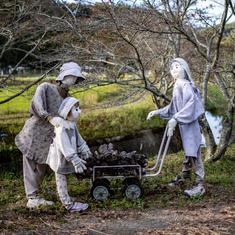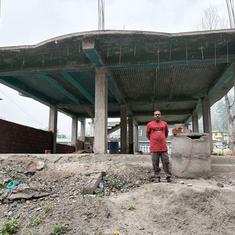The sun is hot as hell, but the wind isn’t. Which makes the weather sort of okay.
That is the first thing you notice when you sit back in what they call a fotingo or “classic car” in Havana in the month of June. These vintage cars, relics of Cuba’s precommunist past, survive because of their ingenuity, so claim their proud owners without exception, as though it is the default statement to make. They are themselves very often the chauffeurs, too. This “ingenuity” they are proud of is similar to what is termed as jugaad in India – the philosophy of being creative and making do with less. Chauffeur Alex, a strong black Cuban dressed like a cowboy, who takes me around Habana Vieja (Old Havana), Vedado and Miramar, the three main localities of the Cuban capital, tells me that most drivers (who are also invariably owners of these vehicles) are pretty good mechanics and know how to fix their cars if there is a problem. They don’t have much choice in the face of uncertain supplies of parts for these mostly American cars due to hostile ties with the neighbouring superpower. “I am a mechanical wizard, having driven this car for the past fifteen years and repaired it almost every day,” he says.
The Cubans too have a concept similar to jugaad – resolver. In Spanish, the word means “to solve”. But in this island nation, the word (in which v is pronounced b) has acquired a much deeper meaning, thanks to the sanctions and the consequent shortage of goods. Making do with what you have is the core of the “resolber” philosophy, like jugaad. Interestingly, a shooter game named Far Cry 6, developed by Ubisoft, is inspired by this Cuban approach to life.
The Oldsmobile convertible I am sitting in is neither very comfortable nor convenient, but then I have no high expectations. The car shudders around turns, but it also makes you look like a mover and shaker on the roads of Havana, except in Miramar, which houses upscale residences and foreign missions. Elsewhere, there are large queues of people waiting to board the guagua who look at you, gravely curious, as you drive past in style in your fotingo . These vintage cars make you look rich and powerful, or so you think. Since you must pay $50 per hour for this ride, you are entitled to this perception, all the more so when you are the only occupant of the car besides the person who drives you around. The chauffeur makes you feel like royalty by opening the door for you. He has to, because there is no way you can get out of this two-door car other than by performing a high jump if he doesn’t. The door is in the front and you are seated at the back.
The fotingo are cars from Ford, Chevrolet, Cadillac, and Chrysler. Then there are the old Russian ones – the Ladas, Volgas and Geelys – besides the Russian Moskvitch 2141. Some of the other brands include DeSotos, Plymouths and Oldsmobiles. According to figures from 2014 (the last available), there are about 60,000 classic cars on the streets of Cuba, most of them in Havana. All these cars, according to their owners, are precious heirlooms passed on from grandfathers to sons and now grandsons. They are painted well and made to look classy and are often parked in a row. Any photo you take of these cars in the foreground with the breathtaking Havana skyline behind is a postcard-worthy image, never mind that some of them are jalopies or what the Cubans call cacharro.
For inter-city transport, Cubans rely mostly on trains and jugaad transport – trucks. Tourists mostly travel in chartered buses that connect Havana to the rest of the cities and tourist spots like the UNESCO-listed Viñales and Pinar del Río. The large air-conditioned buses I saw were the Chinese-made Yutong buses from Zhengzhou Yutong Group Company. Empresa de Omnibus Nacionales (EON or National Bus Company), which falls under the Ministry of Transport, offers interprovincial bus transportation – all on Yutong buses.
The buses operated by EON for Cubans who pay in Cuban pesos (CUP) have a long waiting list, unlike those for tourists who pay in dollars. I was told that people have to book three months in advance to procure a confirmed ticket to avail of such transport services between provinces. Viazul, the bus service from EON for foreign tourists, plies between provinces, and the payment is done in dollars through credit cards, which means Cubans cannot use this. Transtur, a transport company of the Ministry of Tourism, provides transfer services within Havana. There are also hop-on-hop-off buses for city tours. Yutong is used for almost all these services and only the logo and the colour of the buses are different.
In Cuba, which faces fuel shortage and the impact of spiralling fuel prices, the various modes of travel also include colectivos or bicycle taxis; camiones or trucks. For short distances, there are coco-taxis, which are basically miniature versions of Indian auto-rickshaws and are in the shape of a coconut. During the Special Period, in the face of an acute transport crisis, the government had to put to use what are known as camellos, which are eighteen-wheel trucks converted into city buses. ‘With black humour, Cubans call them “Saturday night movies” because of the adult language, sex and violence on board,’ said a report in Reuters back in 2007. Trucks-turned-buses are a recurring feature across most of the Third World. Flying is the easiest – albeit most expensive option – to travel from Havana to other cities down south including Baracoa, Cienfuegos, Guantánamo, Holguín, Santa Clara, Santiago de Cuba and Varadero and a few other destinations as well.
Alex takes me to the parking area next to Havana Cathedral, also known as Catedral de San Cristóbal, in the Plaza de la Catedral in Habana Vieja and then directs me to the church inside. “I will wait for you,” he says. I realise that it has been a dehydrating drive, and the first thing I want to do is quench my thirst. By some divine intervention, I run into a man selling tender coconut water. He chops the coconut in the same fashion as they do in Kerala, with a vettukathi (felling knife or coconut cleaver). I drink it directly from the coconut shell without a straw and order another because it tastes quite like the ones we get in South India. The familiarity comforts me.
I walk slowly around the cathedral compound angling for a good view to take a photo, marvelling at how untouched and unaffected it looks by communism. For someone who had read Fidel Castro’s conversation with Frei Betto on religion, I wasn’t surprised that the motifs of the past as well as traditional and Christian rituals were allowed to coexist with communist ideology. If not earlier, at least since the dawn of this century, cultural and religious symbols of the country are gaining prominence.
Communist parties around the world have changed their stance on religious beliefs. In Kerala, not only are the Kerala Marxists more accommodative of “believer’s concerns” as opposed to total denigration of such sentiments, but they are also now using religious platforms to pull in votes. They do not want to be seen as anti-believers and frequently use symbols, insignias and figures important to multiple religions and sects in their campaigns and hoardings. This is indeed a big departure, and a sign of expediency. In China, the ruling communist party is looking to revive old traditions in an apparent effort to check the effervescence of an organised religion, namely Christianity.
Communist parties, in general, now want to project themselves as forces of resistance against divisive political outfits and global hegemons and not as ideologically rigid entities inimical to religious and ancient beliefs. In Cuba, too, the ruling party takes more pride in its patriotic and nationalist struggle against the United States rather than highlighting ‘class war’ or ideological confrontation. As Richard Gott, a historian and journalist familiar with Cuba and Latin America, points out, Cuba “no longer justifies its existence on the attempts it once made to construct socialism”.
In his 2005 work titled Cuba: A New History, Gott had predicted, “When Castro dies, there will be little change in Cuba. While few people have been looking, the change has already taken place.”
Well, it isn’t easy to contest this statement because geopolitical compulsions seem to be dragging the country in a direction from where it has no choice but to adapt and face new economic challenges besides trying to meet the aspirations of its people. The need to change, therefore, has acquired political, economic and psychological dimensions.

Excerpted with permission from Mad About Cuba: A Malayali Revisits the Revolution, Ullekh NP, Penguin India.










